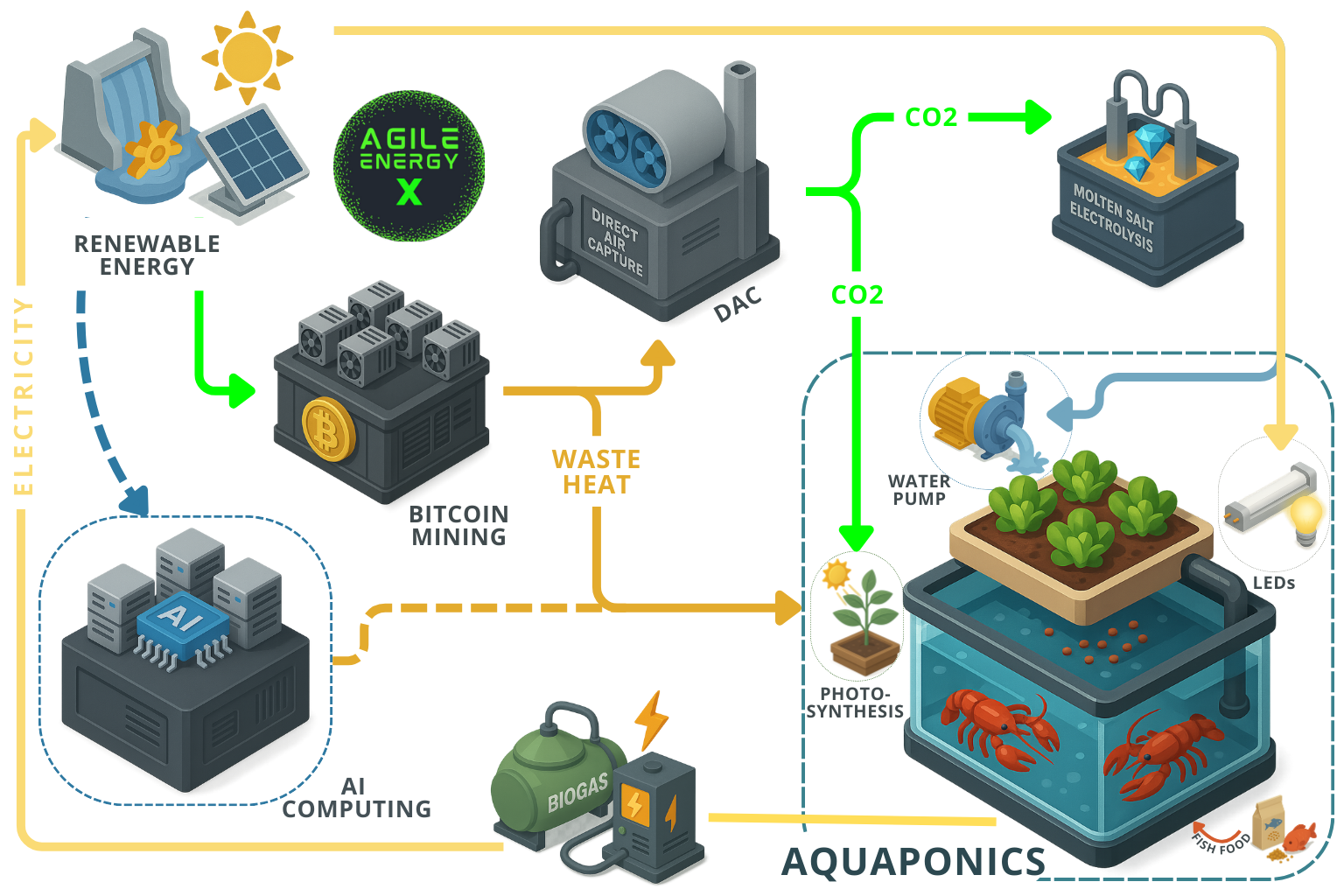How the UCE Loop Works
Integrated Flow
Clean power drives DAC and computing. CO₂ from DAC feeds the molten‑carbonate electrolyzer to make solid carbon (graphite). Computing heat is recovered to warm fish tanks and greenhouses. Concentrated CO₂ is metered into greenhouses to boost photosynthesis. Biological wastes go to a digester → biogas → heat/power, with digestate returned as fertilizer — closing the loop.
- Initial dispatchable data center: ~5–10 MW at GMC; acts as a flexible load for grid stability.
- DAC costs are currently ~$500–800 per tCO₂ but falling with scale and innovation.
UCE Flowchart*

*Conceptual
Policy & GNH Alignment
- NEP 2025: Enables 10× renewables, private/foreign investment, and emerging tech (DAC, hydrogen, waste‑to‑energy). UCE converts surplus clean power into value‑added products and grid flexibility.
- GNH Pillars: Sustainable growth & jobs, environmental conservation via CO₂ removal, cultural preservation via mindful design, and transparent PPP governance.
Bhutan × Japan Partnership
Japan contributes advanced tech, capital (ODA/JBIC/JICA), and market demand (battery‑grade graphite); Bhutan contributes 24/7 green power, GNH‑driven governance, and the GMC SAR as an agile sandbox. Cooperative Article‑6 pathways allow shared crediting of verified CO₂ removals.
Key Metric
| Metric | Value | |
|---|---|---|
| Renewables target (by 2040) | ≈ 25,000 MW (10× today) | |
| Youth unemployment (2023) | ≈ 29% | |
| Winter peak vs firm hydro | ≈ 125% (peak exceeds firm supply) | |
| Pilot data center | ~5–10 MW, dispatchable | |
| Immersion heat reclaim | Hot water ~60–70 °C, near‑total recovery | |
| DAC current cost | ~$500–800 per tCO₂ | |
| Greenhouse enrichment | ≈ 800–1000 ppm CO₂ | |
| CO₂ → C conversion example | 5,000 tCO₂ → ≈ 1,360 t carbon / year |
Projected Revenue
Overall Contribution to UCE (Economic + Energy + Social Impact)
Projected using GPT-5 taking Key metrics into major consideration
Impact and Benefits
 Environmental
Environmental
Permanent removals at pilot scale, rising to megatons with scale; double‑use energy (compute → heat) and low‑runoff aquaponics reduce footprints; supports Bhutan's 60% forest cover mandate by intensifying production.
 Economic
Economic
Diversifies into graphite exports, digital services, and winter food; stacks revenues (Bitcoin/data, carbon credits, produce) to de‑risk returns; attracts mindful FDI and tech transfer.
 Social
Social
Green jobs for youth, affordable fresh fish and vegetables, community heat reuse, education & visitor center — a living lab for GNH.
FAQ
Is Bitcoin mining compatible with climate goals?
Yes — in UCE it runs on Bhutan’s renewables and acts like a “heat engine” for food, while also operating as a flexible load that can throttle during grid stress.
Why convert CO₂ to graphite?
It turns climate liability into an export product (battery anodes). Electrolysis in molten carbonates has produced high‑purity graphite at far lower temperatures than conventional routes.
Will this help food security?
Yes. Miner heat keeps greenhouses productive through winter; CO₂ enrichment boosts yields; aquaponics recycles water and nutrients — reducing imports and price volatility.
How is it governed?
A transparent PPP in the GMC SAR with clear profit‑sharing, tech transfer, and community benefits; joint steering with Japan; Article‑6 cooperation for removals.
References & Sources
- National Energy Policy 2025 – MoENR, Bhutan
- MoENR summary page
- Gelephu Mindfulness City – TIME Magazine
- Druk Holding and Investments (DHI)
- Climeworks DAC
- SyncMOF (Japan)
- Agile Energy X Official
- Agile Energy X UCE Demo
- Genesis Mining
- MintGreen
- FAO Aquaponics Guidelines
- Mealworm Life Cycle – The Hive Explorer
- Mealworm Article – Voice of Youth Japan
- International Renewable Energy Agency (IRENA)
- Japan JCM
- JICA
- JBIC
- NEDO
- Asian Development Bank (ADB)
- Green Climate Fund (GCF)
- Gross National Happiness – Bhutan
- Society 5.0 – Japan Cabinet Office